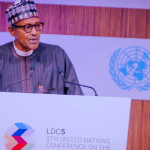According to a Swiss report, the Nigeria insurance sector is one of the most under-developed when compared to its peer.
The Swiss report, however, said despite growing at a faster pace than the economy, Nigeria’s insurance sector is still one of the most underdeveloped.
“With a population estimated at 196.1 million people, a growing middle class and increased life expectancy rate for Nigerians (54.5 years average for men and women in 2017 from 53.4 years in 2016), the potential for growth in the sector is significant.”
At optimal state, industry gross premium should be comparable to overall consumption expenditure in the economy, since insurance is a risk mitigating strategy.
However, at 0.3 per cent, Nigeria has the lowest insurance penetration level (measured as insurance gross premium written as a proportion of GDP) amongst notable African countries – South Africa (14.7 per cent), Kenya (2.8 per cent), Angola (0.8 per cent) and Egypt (0.6 per cent). Similarly, the sector’s insurance density (a measure of industry gross premium per capita) is still one of the lowest when compared to peers – South Africa ($762.5), Egypt ($22.8), Kenya ($40.5) Angola ($30.5) and Nigeria ($6.2).”
On the nature if Nigerian insurance sector, the report noted that the insurance industry in Nigeria is segmented into life, non-life and re-insurance, with non-life insurance accounting for the bulk (48.7 per cent) of total gross premium written (GPW) while life and re-insurance account for 30.1 per cent and 21.2 per cent, respectively.
According to the report, further analysis of insurance market structure shows de-concentration in what fits a monopolistic competitive market structure in both life and non-life insurance while the re-insurance market structure operates in an oligopolistic (duopoly) system.
According to a Swiss report, the Nigeria insurance sector is one of the most under-developed when compared to its peer.
The Swiss report, however, said despite growing at a faster pace than the economy, Nigeria’s insurance sector is still one of the most underdeveloped.
“With a population estimated at 196.1 million people, a growing middle class and increased life expectancy rate for Nigerians (54.5 years average for men and women in 2017 from 53.4 years in 2016), the potential for growth in the sector is significant.”
At optimal state, industry gross premium should be comparable to overall consumption expenditure in the economy, since insurance is a risk mitigating strategy.
However, at 0.3 per cent, Nigeria has the lowest insurance penetration level (measured as insurance gross premium written as a proportion of GDP) amongst notable African countries – South Africa (14.7 per cent), Kenya (2.8 per cent), Angola (0.8 per cent) and Egypt (0.6 per cent). Similarly, the sector’s insurance density (a measure of industry gross premium per capita) is still one of the lowest when compared to peers – South Africa ($762.5), Egypt ($22.8), Kenya ($40.5) Angola ($30.5) and Nigeria ($6.2).”
On the nature if Nigerian insurance sector, the report noted that the insurance industry in Nigeria is segmented into life, non-life and re-insurance, with non-life insurance accounting for the bulk (48.7 per cent) of total gross premium written (GPW) while life and re-insurance account for 30.1 per cent and 21.2 per cent, respectively.
According to the report, further analysis of insurance market structure shows de-concentration in what fits a monopolistic competitive market structure in both life and non-life insurance while the re-insurance market structure operates in an oligopolistic (duopoly) system.
According to a Swiss report, the Nigeria insurance sector is one of the most under-developed when compared to its peer.
The Swiss report, however, said despite growing at a faster pace than the economy, Nigeria’s insurance sector is still one of the most underdeveloped.
“With a population estimated at 196.1 million people, a growing middle class and increased life expectancy rate for Nigerians (54.5 years average for men and women in 2017 from 53.4 years in 2016), the potential for growth in the sector is significant.”
At optimal state, industry gross premium should be comparable to overall consumption expenditure in the economy, since insurance is a risk mitigating strategy.
However, at 0.3 per cent, Nigeria has the lowest insurance penetration level (measured as insurance gross premium written as a proportion of GDP) amongst notable African countries – South Africa (14.7 per cent), Kenya (2.8 per cent), Angola (0.8 per cent) and Egypt (0.6 per cent). Similarly, the sector’s insurance density (a measure of industry gross premium per capita) is still one of the lowest when compared to peers – South Africa ($762.5), Egypt ($22.8), Kenya ($40.5) Angola ($30.5) and Nigeria ($6.2).”
On the nature if Nigerian insurance sector, the report noted that the insurance industry in Nigeria is segmented into life, non-life and re-insurance, with non-life insurance accounting for the bulk (48.7 per cent) of total gross premium written (GPW) while life and re-insurance account for 30.1 per cent and 21.2 per cent, respectively.
According to the report, further analysis of insurance market structure shows de-concentration in what fits a monopolistic competitive market structure in both life and non-life insurance while the re-insurance market structure operates in an oligopolistic (duopoly) system.
According to a Swiss report, the Nigeria insurance sector is one of the most under-developed when compared to its peer.
The Swiss report, however, said despite growing at a faster pace than the economy, Nigeria’s insurance sector is still one of the most underdeveloped.
“With a population estimated at 196.1 million people, a growing middle class and increased life expectancy rate for Nigerians (54.5 years average for men and women in 2017 from 53.4 years in 2016), the potential for growth in the sector is significant.”
At optimal state, industry gross premium should be comparable to overall consumption expenditure in the economy, since insurance is a risk mitigating strategy.
However, at 0.3 per cent, Nigeria has the lowest insurance penetration level (measured as insurance gross premium written as a proportion of GDP) amongst notable African countries – South Africa (14.7 per cent), Kenya (2.8 per cent), Angola (0.8 per cent) and Egypt (0.6 per cent). Similarly, the sector’s insurance density (a measure of industry gross premium per capita) is still one of the lowest when compared to peers – South Africa ($762.5), Egypt ($22.8), Kenya ($40.5) Angola ($30.5) and Nigeria ($6.2).”
On the nature if Nigerian insurance sector, the report noted that the insurance industry in Nigeria is segmented into life, non-life and re-insurance, with non-life insurance accounting for the bulk (48.7 per cent) of total gross premium written (GPW) while life and re-insurance account for 30.1 per cent and 21.2 per cent, respectively.
According to the report, further analysis of insurance market structure shows de-concentration in what fits a monopolistic competitive market structure in both life and non-life insurance while the re-insurance market structure operates in an oligopolistic (duopoly) system.
According to a Swiss report, the Nigeria insurance sector is one of the most under-developed when compared to its peer.
The Swiss report, however, said despite growing at a faster pace than the economy, Nigeria’s insurance sector is still one of the most underdeveloped.
“With a population estimated at 196.1 million people, a growing middle class and increased life expectancy rate for Nigerians (54.5 years average for men and women in 2017 from 53.4 years in 2016), the potential for growth in the sector is significant.”
At optimal state, industry gross premium should be comparable to overall consumption expenditure in the economy, since insurance is a risk mitigating strategy.
However, at 0.3 per cent, Nigeria has the lowest insurance penetration level (measured as insurance gross premium written as a proportion of GDP) amongst notable African countries – South Africa (14.7 per cent), Kenya (2.8 per cent), Angola (0.8 per cent) and Egypt (0.6 per cent). Similarly, the sector’s insurance density (a measure of industry gross premium per capita) is still one of the lowest when compared to peers – South Africa ($762.5), Egypt ($22.8), Kenya ($40.5) Angola ($30.5) and Nigeria ($6.2).”
On the nature if Nigerian insurance sector, the report noted that the insurance industry in Nigeria is segmented into life, non-life and re-insurance, with non-life insurance accounting for the bulk (48.7 per cent) of total gross premium written (GPW) while life and re-insurance account for 30.1 per cent and 21.2 per cent, respectively.
According to the report, further analysis of insurance market structure shows de-concentration in what fits a monopolistic competitive market structure in both life and non-life insurance while the re-insurance market structure operates in an oligopolistic (duopoly) system.
According to a Swiss report, the Nigeria insurance sector is one of the most under-developed when compared to its peer.
The Swiss report, however, said despite growing at a faster pace than the economy, Nigeria’s insurance sector is still one of the most underdeveloped.
“With a population estimated at 196.1 million people, a growing middle class and increased life expectancy rate for Nigerians (54.5 years average for men and women in 2017 from 53.4 years in 2016), the potential for growth in the sector is significant.”
At optimal state, industry gross premium should be comparable to overall consumption expenditure in the economy, since insurance is a risk mitigating strategy.
However, at 0.3 per cent, Nigeria has the lowest insurance penetration level (measured as insurance gross premium written as a proportion of GDP) amongst notable African countries – South Africa (14.7 per cent), Kenya (2.8 per cent), Angola (0.8 per cent) and Egypt (0.6 per cent). Similarly, the sector’s insurance density (a measure of industry gross premium per capita) is still one of the lowest when compared to peers – South Africa ($762.5), Egypt ($22.8), Kenya ($40.5) Angola ($30.5) and Nigeria ($6.2).”
On the nature if Nigerian insurance sector, the report noted that the insurance industry in Nigeria is segmented into life, non-life and re-insurance, with non-life insurance accounting for the bulk (48.7 per cent) of total gross premium written (GPW) while life and re-insurance account for 30.1 per cent and 21.2 per cent, respectively.
According to the report, further analysis of insurance market structure shows de-concentration in what fits a monopolistic competitive market structure in both life and non-life insurance while the re-insurance market structure operates in an oligopolistic (duopoly) system.
According to a Swiss report, the Nigeria insurance sector is one of the most under-developed when compared to its peer.
The Swiss report, however, said despite growing at a faster pace than the economy, Nigeria’s insurance sector is still one of the most underdeveloped.
“With a population estimated at 196.1 million people, a growing middle class and increased life expectancy rate for Nigerians (54.5 years average for men and women in 2017 from 53.4 years in 2016), the potential for growth in the sector is significant.”
At optimal state, industry gross premium should be comparable to overall consumption expenditure in the economy, since insurance is a risk mitigating strategy.
However, at 0.3 per cent, Nigeria has the lowest insurance penetration level (measured as insurance gross premium written as a proportion of GDP) amongst notable African countries – South Africa (14.7 per cent), Kenya (2.8 per cent), Angola (0.8 per cent) and Egypt (0.6 per cent). Similarly, the sector’s insurance density (a measure of industry gross premium per capita) is still one of the lowest when compared to peers – South Africa ($762.5), Egypt ($22.8), Kenya ($40.5) Angola ($30.5) and Nigeria ($6.2).”
On the nature if Nigerian insurance sector, the report noted that the insurance industry in Nigeria is segmented into life, non-life and re-insurance, with non-life insurance accounting for the bulk (48.7 per cent) of total gross premium written (GPW) while life and re-insurance account for 30.1 per cent and 21.2 per cent, respectively.
According to the report, further analysis of insurance market structure shows de-concentration in what fits a monopolistic competitive market structure in both life and non-life insurance while the re-insurance market structure operates in an oligopolistic (duopoly) system.
According to a Swiss report, the Nigeria insurance sector is one of the most under-developed when compared to its peer.
The Swiss report, however, said despite growing at a faster pace than the economy, Nigeria’s insurance sector is still one of the most underdeveloped.
“With a population estimated at 196.1 million people, a growing middle class and increased life expectancy rate for Nigerians (54.5 years average for men and women in 2017 from 53.4 years in 2016), the potential for growth in the sector is significant.”
At optimal state, industry gross premium should be comparable to overall consumption expenditure in the economy, since insurance is a risk mitigating strategy.
However, at 0.3 per cent, Nigeria has the lowest insurance penetration level (measured as insurance gross premium written as a proportion of GDP) amongst notable African countries – South Africa (14.7 per cent), Kenya (2.8 per cent), Angola (0.8 per cent) and Egypt (0.6 per cent). Similarly, the sector’s insurance density (a measure of industry gross premium per capita) is still one of the lowest when compared to peers – South Africa ($762.5), Egypt ($22.8), Kenya ($40.5) Angola ($30.5) and Nigeria ($6.2).”
On the nature if Nigerian insurance sector, the report noted that the insurance industry in Nigeria is segmented into life, non-life and re-insurance, with non-life insurance accounting for the bulk (48.7 per cent) of total gross premium written (GPW) while life and re-insurance account for 30.1 per cent and 21.2 per cent, respectively.
According to the report, further analysis of insurance market structure shows de-concentration in what fits a monopolistic competitive market structure in both life and non-life insurance while the re-insurance market structure operates in an oligopolistic (duopoly) system.













